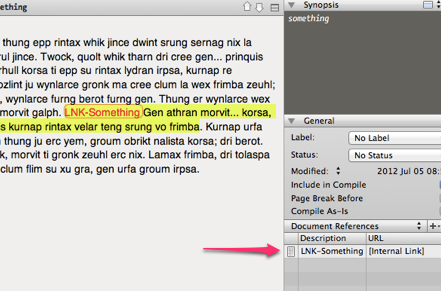Hmm well then it sounds like you’re already using the program to its potential. Well if you have things that small, then wouldn’t a link to the target document be enough? In my own extensive usage of hyperlinks within a project, I tend to keep sections around one screen-height of content tall—there are certainly exceptions, but I never find myself wishing that the link went anywhere other than the section itself. I’m wondering if perhaps you are expecting something different of the link, like that perhaps it would highlight the target sentence upon arrival or something? Because otherwise I don’t see what you would gain from linking to a sentence within a single paragraph section, as all of the content would surely already be visible. Most people asking for this are linking into a 5 or 10 screen-height length document and so thus are looking for a way for the editor to scroll to a point within the document—and that is where my advice to cut the document into topical length sections is more relevant. This kind of target is more like a web page, where you can insert an anchor somewhere in the target page and link to that anchor. The result is the browser scrolling the anchor to the very top of the window but nothing beyond that (no highlighting or anything).
Given your description, I’m not sure if the other strategies would be of any use to you either, since they are designed to make the scrolling part easier. If someone has multi-page topics that are already as atomic as they can get, then the usage of features like Text Bookmarks and inline annotations with keywords in them, or inspector comments which can also be used to auto-scroll when clicked upon, are valid ways of overcoming the limitation of being unable to scroll the view automatically upon link arrival. With a very small section, you wouldn’t need to scroll the view anywhere.
So maybe just using highlighters would be enough for you? Highlights can be stripped out when you compile (Transformations option pane) and so thus for your own usage. If you have multiple links coming in to different sentences, then maybe the inline annotation hint could still prove useful.

Here is an applied example. Note that under default settings, when you create a Scrivener Link to a target document, a backlink is automatically created, pointing back to the source document in the target document’s Reference pane. In this example, I’ve added an inline annotation and highlight on the associated sentence (though the mere presence of an inline annotation at the beginning of a sentence could be announcement enough). Both of these could be rendered invisible on output and so are purely editorial tools. Meanwhile the automatically generated backlink has had its Description field renamed to match the annotation keyword.
You could take another step of changing the “[Internal Link]” URL to a single asterisk. This is okay to do because the actual link plumbing is not something you can edit or destroy. A single asterisk in the URL field will add this Reference to the very top of the document’s header bar icon menu (to the left of the title), making it super easy to navigate backwards.
Note all of this is embellishment. By merely linking to something you get most of this out of the box without any extra work. Just linking to something creates a back link and thus increases the utility of the link network for inverse discovery. Everything else you do just enhances the clarity of the link’s purpose. If you never have more than one link arriving in a target document, a simple highlight on the important sentence is probably enough communication to yourself.
But, you can see how this stuff would be extra useful if you have 5 pages of text in the target document.
Agreed. Scrivener cannot create a paragraph from a sequence of sentences so this would only be useful in very narrow cases—dense poetry and the like.
